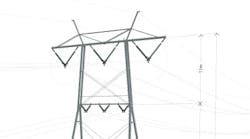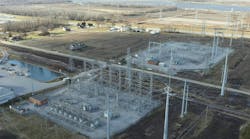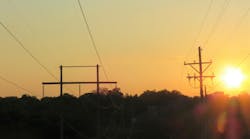Fingrid Oyj, which is responsible for the electricity transmission grid in Finland, has developed a new type of transmission line tower for use on fields. The new tower has been designed to minimize the disadvantage inflicted on agriculture and to improve occupational safety. The new tower type facilitates soil preparation and cultivation.
“We believe that landowners will welcome the new field tower model. After all, the idea for a tower which saves arable land was obtained directly from landowners at agricultural exhibitions, where we have been represented in several summers. The foremost significance of the Farmari agricultural exhibition for us is that we receive feedback from landowners on whose land our lines run,” says Fingrid’s Executive Vice President Kari Kuusela in Pori.
Transmission system operator Fingrid is an international trailblazer in combining industrial design and technical constructions. The company has previously developed so-called landscape towers, and the new field tower continues these open-minded development efforts.
The development of the tower model started a couple of years ago in co-operation with design agency Muotohiomo Oy. The objective was to devise a new type of double-circuit tower for 400-kV and 110-kV transmission lines.
The height of the tower is in the same range as that of a conventional 400-kV tower, where the upper crossarm is at a height of 31 m to 35 m. The most notable difference between the field tower and conventional tower types is that the field tower has no supporting guy wires. Agricultural machinery can be operated more freely near the new tower than in the vicinity of conventional guyed towers. Many common agricultural machines can run under the tower, since the space under the tower is 7 m in the longitudinal direction and 14 m in the cross direction.
Protective structures surrounding the legs of the new tower prevent potential collisions with the legs. In this way, soil can be worked quite close to the tower. Since the new towers have no guys, weeding problems in the surroundings are also significantly reduced.
The foundations of the tower are composed of two prefabricated concrete sections joined together. Each part weighs 3 tons. The four-legged tower is anchored to the ground using foundations of 24 tons. Separate concreting work is not required, but the entire foundation is built as prefabricated constructions.
“The new tower model is more expensive for us than the traditional tower type, but the reduced disadvantages for agriculture are a major improvement. We estimate that over the long term, collision damage will also be reduced, ” Kari Kuusela says in describing the background of the design of the new tower type.
In use between
Pori and Kristiinankaupunki
The field towers will primarily be used in the construction of new transmission lines. They can also be erected on existing lines in conjunction with the replacement of a line or some its towers.
The field tower is used on the 400-kV transmission line between the Ulvila substation in Pori and the Kristinestad substation in Kristiinankaupunki in Western Finland. However, conventional structures are used for most of the transmission line route, because the line primarily runs in forest.
The 115-km power line to be completed in 2014 will replace the technically outdated transmission network in the region. In Western Finland, preparations must also be made for a significant increase in electricity transmission needs. Electricity consumption has grown particularly rapidly in the Vaasa, Kristiinankaupunki and Seinäjoki regions. The project will also achieve significant savings in the form of reduced loss energy.
The transmission line between Pori and Kristiinankaupunki is part of the long-term development plan of the Finnish transmission grid, making preparations for integrating new electricity generation capacity – wind power and nuclear power – to the grid. Fingrid’s capital expenditure has consequently grown significantly and will total more than 260 million euros this year.
“Fingrid intends to build a total of approximately 3,000 km of new transmission lines and about 30 substations. Approximately 90 per cent of the new transmission lines will be built in existing rights-of-ways or parallel with them. This principle aims to reduce the inconvenience inflicted on landowners,” Kari Kuusela points out.
“Overall, the rapid pace of construction requires from us active dialogue with landowners in land use planning and construction planning. This is one of the reasons why we participate in the Farmari exhibitions, where we can communicate our topical projects. In the region of Satakunta, the environmental impact assessment for the transmission lines required by the Olkiluoto 4 nuclear power plant project is currently being launched alongside the construction of the Ulvila–Kristinestad transmission line. The environmental impact assessment will study the transmission line routes from Olkiluoto to Rauma and further to Ulvila, Forssa and Lieto,” Kari Kuusela says.



